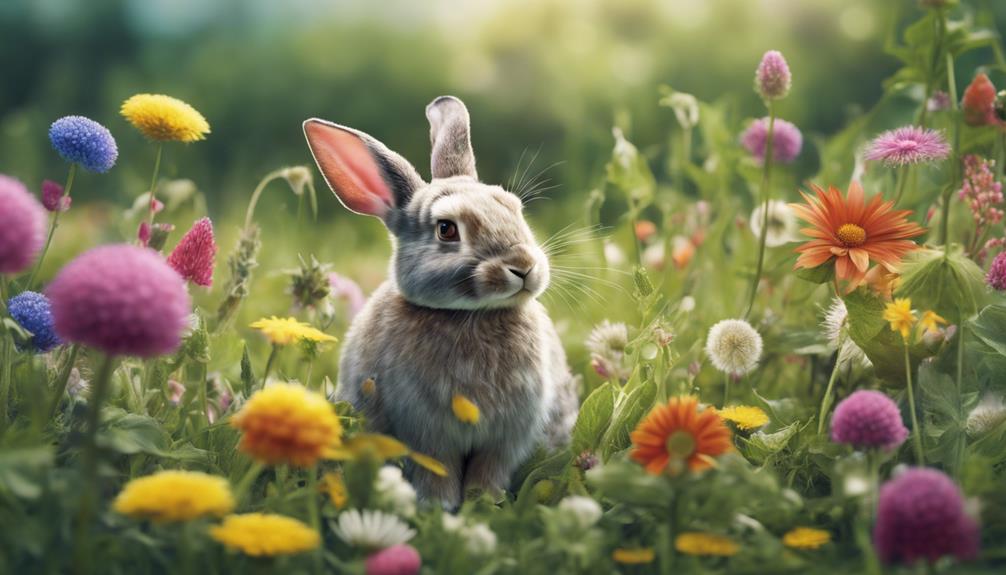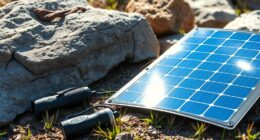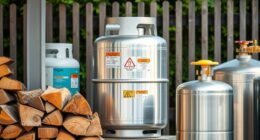As a loving bunny owner, you want the best for your pet. A proper diet is key to their health. But finding the right amount to feed can be tricky. You need to feed them enough for their nutrition without giving too much or too little. Let’s look into how much forage your bunny needs for their best health.
Rabbits need access to fresh, clean water at all times. Choose a heavy bowl or a drip-feed bottle to keep them hydrated. Good hydration is important for their health and helps prevent dehydration.
Hay is a must-have in a rabbit’s diet. Offer plenty of high-quality hay daily. Experts say to give them a bundle of hay as big as they are every day. Hay helps with fiber intake, keeps teeth healthy, and aids digestion.
Rabbits also love to graze on grass or kiln-dried grass. It’s a natural activity that adds nutrients and fun. Let them graze in a safe, chemical-free backyard, or offer kiln-dried grass.
Include different greens in your rabbit’s meals. Offer fresh veggies daily, slowly adding new ones. Choose leafy greens like kale and spinach, and be careful with sugary veggies like carrots.
Treats make diet fun but give them sparingly. Go for high-fiber fruits like strawberries, papaya, and apples in small bits as treats. This keeps treats healthy and exciting.
When it comes to pellets, pick the right kind and amount. Timothy pellets are a great choice. Give about 1/8 to 1/4 cup per 5 lbs of your rabbit’s weight1. This helps them get nutrients without overeating.
Adjust food amounts based on your rabbit’s age and weight. Young rabbits grow fast and can have more pellets2. Adults need their pellet intake adjusted by weight. For example, a rabbit weighing 2-4 pounds needs 1/8 cup of pellets. For a 5-7 pound rabbit, 1/4 cup is good. And so on, depending on their size2.
Every rabbit is different in how much water and food they need. A guideline is at least 1 cup of fresh food per 5 pounds of body weight, twice a day2. Talk to a vet to find out the best portions for your bunny.
Understanding proper rabbit feed is key. By giving the right amounts of hay, greens, pellets, and treats, you’ll keep your rabbit healthy and happy. They all have their own likes and needs. Watching and talking to a vet will help you get their diet just right. A well-fed bunny is a joyful one!
Key Takeaways:
- Provide constant access to fresh, clean water for your rabbit’s hydration needs.
- Offer good quality hay in generous amounts to promote digestion and dental health.
- Incorporate a variety of fresh leafy greens into your rabbit’s diet, introducing new types gradually.
- Choose Timothy pellets and provide approximately 1/8 to 1/4 cup per 5 lbs (2.25 kg) of body weight for adult rabbits.
- Avoid muesli-style foods and opt for balanced pellet options to prevent selective feeding.
- Adjust food portions based on your rabbit’s weight and consult a veterinarian for specific dietary needs.
Importance of Water and Hay in a Rabbit’s Diet
Rabbits need water and hay to stay healthy and happy. These two things are super important for their diet. Every rabbit owner should know how crucial water and hay are for their pets.
Water for Rabbits
Just like us, rabbits need water to live. It’s important for them to always have fresh, clean water. You can give them water in a sturdy bowl or a bottle that drips water. Make sure the water stays clean and doesn’t get too hot or freeze.
Drinking enough water keeps a rabbit healthy and helps their digestion. It stops dehydration, urinary problems, and stasis. Stasis can be really bad because it stops their digestion. Making sure rabbits drink enough water is key to keeping them well3.
Rabbit Hay Intake
Hay is a must in a rabbit’s diet because their bodies are made to digest grass and hay. Wild rabbits spend most of their day eating grass. That’s why domestic rabbits need lots of grass and hay, too.
Hay has fiber, which is good for their digestion. It stops stomach problems and helps their teeth stay healthy. Rabbits’ teeth grow a lot, so chewing hay keeps them from getting too long. This avoids mouth pain and other issues4.
Rabbits should always have hay. The amount should be as big as they are each day. Always having hay helps them stay healthy and keeps their teeth in good shape4.
There are different kinds of hay, and each kind has its benefits. Young or nursing rabbits might need alfalfa hay, which is rich in calcium and protein. Adult rabbits do well with Timothy or Meadow hay. Letting them try various hays can give them extra nutrition4.
Getting rabbits to eat enough hay can be hard if they like other foods more. But you can try a few things. Give them less pellets or muesli-style foods. Try different hays or mix tasty foods with the hay. You can use different hay types or mix in some yummy herbs. Also, putting hay everywhere they go and making it fun can get them interested. Slowly getting them used to hay by giving them fresh grass can work, too4.
Feeding Greens and Other Vegetables to Rabbits
Adding fresh greens and vegetables to a rabbit’s diet is key. These foods are full of important vitamins and minerals. They also make your rabbit’s meals more interesting. It’s good to give them different greens and veggies to keep their diet balanced.
Experts say rabbits should get 8-10% of their food from greens and veggies5. This means greens are a big part of what they eat daily. Aim to give about 1 cup of dark leafy greens per 2 pounds of your rabbit’s weight each day5. Safe choices include lettuce, spinach, kale, and watercress.
Rabbits also like eating non-leafy veggies5. Give them about 1 tablespoon per 2 pounds of their weight every day5. You can choose from broccoli, celery, bell peppers, and squash.
It’s important to mix up the greens and veggies you offer your rabbit5. Try to give them 3 to 5 different kinds daily. This mix of leafy and non-leafy veggies ensures they get many nutrients they need for good health.
Always pick organic greens and veggies to avoid harmful pesticides5. Some safe options include lettuce, spinach, kale, watercress, and broccoli. These provide vital nutrients and are safe for your rabbit.
However, be careful with some veggies. Avoid iceberg lettuce, rhubarb, onions, leeks, and garlic5. Also, feed parsley, spinach, and mustard greens in moderation if your rabbit has bladder issues. Vegetables like broccoli and cabbage can upset sensitive stomachs.
Introduce new veggies to your rabbit one at a time6. This way, you can spot any problems easily. It helps keep their digestive system in check.
While veggies are crucial, they shouldn’t be all your rabbit eats. Most of their diet should be quality grass hay and specific pelleted food5. Don’t forget, rabbits always need access to clean, fresh water7.
A balanced diet with varied greens and veggies will keep your rabbit healthy and happy.
Feeding Pellets or Nuggets to Rabbits
Pellets or nuggets are key to feeding rabbits. They supply needed nutrients and keep them healthy8. These foods are specially made to match what rabbits need to eat every day.
You should feed your rabbit 25g of pellets for each kg they weigh9. This amount helps them grow strong and stay healthy. But remember, pellets are just a part! Most of their food should be hay10.
Rabbits shouldn’t eat foods mixed like muesli9. These mixes can make them pick and choose, leading to poor nutrition. Always choose quality pellets to keep their diet balanced and healthy.
Pellets aren’t just food, but also great for training treats9. Using their food as rewards can help teach them new things. It also helps you bond with your rabbit.
Each rabbit is different and might need special food9. Young, pregnant, or sick rabbits have other needs. A vet can help pick the right diet for them.
A healthy rabbit diet includes hay, greens, and some pellets8. This combination supports their health and happiness. It’s key for a long, happy life for your rabbit.
Adjusting Rabbit’s Food Based on Weight and Individual Needs
It’s key to adjust a rabbit’s food to keep them at a healthy weight. This means looking at their size and any special needs they may have.
For the right food amount, use 25g (like an eggcup) of pellets for each kg the rabbit weighs. This avoids too much food and keeps their diet right without obesity risks11. Regular weight checks help you change their diet as needed12.
Rabbits with different needs may need diet changes. This includes young, pregnant, nursing, or sick rabbits. Always ask a vet for advice in these cases12.
Many things can affect what a rabbit needs to eat. This includes the weather, how stressed they are, and how much they move. Rabbits that don’t move much, are older, or are very large usually need less food11. Rabbits outside might eat more because they’re more active, but indoor rabbits should eat less to not get overweight11.
By paying attention to a rabbit’s specific needs and adjusting their food, you can help them stay healthy. This keeps obesity at bay and makes sure they get the nutrients they need1211.
Factors to Consider in Determining Portion Size for Rabbits
Determining the right food amount for rabbits is key to their health. You must think about several things to make sure they get enough to eat. These things include:
- Rabbit Size and Body Condition Score: A rabbit’s size and body shape significantly impact how much they should eat. The Pet Food Manufacturer’s Association has a Rabbit Size-O-Meter. It checks if a rabbit is too heavy, too thin, or just right13.
- Size of the Rabbit: Big rabbits usually eat more than small ones. Always look at the breed and size of your rabbit when figuring out food amounts.
- Activity Level: Active rabbits, like those roaming around a lot, might eat more. They need more food to keep up their energy.
- Lifestyle: A rabbit’s way of life affects how much they eat. Types of rabbits that do shows or breed need more food for their busy lives.
- Nutritional Requirements: Different stages of life and specific diet needs also play a role. Young rabbits grow fast and need more food. Adult rabbits need less to keep a healthy weight14.
Regularly check a rabbit’s weight to adjust food as needed. This helps stop them from getting too fat or too thin13.

Finding the right food balance is important. Too much food can cause obesity and health problems. Not enough can cause weight loss and malnutrition. Always talk to a vet or a rabbit expert for advice on how much to feed your rabbit. Companies like Oxbow Animal Health, Small Pet Select, and Sherwood Pet Health provide high-quality rabbit food15.
Preventing Obesity in Rabbits
Rabbit obesity is a serious issue. It can really affect their health and how long they live. To stop your rabbit from getting too heavy, you need to control how much they eat. You’ve also got to make sure their diet is balanced. If a rabbit gains too much weight, they could face lots of problems. These include issues with their stomach, joint pain, and a shorter life. By sticking to feeding rules and taking good care of your rabbit, you can help them stay at a healthy weight.
Importance of Portion Control
Giving the right amount of food is key to fighting rabbit obesity16.
Controlling food portions helps manage a rabbit’s weight. Rabbit food has more calories than hay or grass. So it’s important not to give too much. Rabbits who have been fixed gain weight easier. So watch their food closely. Rabbits eat less as they get older or less active. Remember, every rabbit is different. They might need different amounts of food based on their breed or where they live. It’s smart to adjust how much they eat when needed. You should also weigh your rabbit often to keep them from getting overweight.
Feeding Guidelines for a Balanced Diet
A balanced diet is crucial for stopping rabbit obesity17. Make sure to feed them the right mix of hay, veggies, and pellets.
Hay is a must-have in a rabbit’s meal plan. Most of their diet should be hay. The amount of hay they should eat is about as big as they are. Hay is great for their stomach and keeps their teeth healthy. Choose grass or timothy hay for adult rabbits because these have fewer calories. Pellets should be high in fiber but low in protein. Don’t feed them more than 1/8 cup of pellets per 5 lbs. of body weight each day. Avoid mixes with dried fruits or nuts since they’re too sugary.
Adding Fresh Vegetables and Fruits
Fresh veggies and fruits are a must to prevent rabbit obesity1617.
Adding a variety of fresh veggies to your rabbit’s diet is important. They need at least four big cups of veggies every day. Go for leafy greens like kale but mix in other vegetables carefully. Carrots and bell peppers are fine but only in small amounts. Fruits should be a rare treat, given in tiny bits. This way, your rabbit gets the nutrients without too much sugar.
Exercise and Environmental Enrichment
Rabbits need lots of exercise to stay slim. They should have plenty of room to move and stretch. To get them moving, let them roam in a safe area. Make sure it’s safe from dangers. Toys and tunnels can also make them more active. Hiding their food so they have to find it is another great trick to keep them fit.
Gradual Dietary Changes
Change their food slowly to avoid upset stomachs. Sudden changes can be bad for their digestion. Always talk to a vet before making any big changes to what your rabbit eats. This will help you manage their weight better.
Keeping control of your rabbit’s food and making sure they eat right are key moves to prevent obesity. Make sure they see a vet regularly, especially because their exact food needs can vary. A healthy weight is very important for their overall health and a long life.

| Nutrition Guidelines for Preventing Obesity in Rabbits | Portion Control Recommendations |
|---|---|
| Feed unlimited quantities of grass hay for good intestinal health16. | Feed no more than 1/8 cup of quality pellets per 5 lbs. of rabbit per day16. |
| Ensure rabbits receive at least four heaping cups of fresh vegetables per day16. | Limit fresh fruit to no more than two tablespoons a day for a five-pound rabbit16. |
| Avoid commercial “gourmet” or “treat” mixes filled with dried fruit, nuts, and seeds16. |
Addressing Weight Loss and Increasing Caloric Intake in Rabbits
If your rabbit is losing weight, it might be sick. Talking to a vet is key if your bunny seems thinner or is losing weight without a reason. Sometimes, smaller rabbits or those who are more active might need to eat more. On the other hand, some rabbits should eat less. Keeping an eye on their weight and adjusting how much they eat can help.
Rabbits eat a lot of fiber that’s hard to digest18. For healthy weight gain, it’s crucial their diet has enough energy. They eat around 5% of their body weight in dry food daily18. To gain weight well, they should get about 2,200 calories for each kilogram of their diet18.
Rabbits need at least 20-25% fiber in their diet for a healthy gut18. High-quality hay, like Timothy Hay, is great for this. Hay should be a big part of their diet, while foods like pellets should be given in small amounts, just like a treat19.
Diets high in starch can be very harmful, leading to stomach issues or even death18. It’s best to avoid grains and other sugary or starchy foods. Fruits high in fiber, like apples and pears, are better than sugary ones like grapes and bananas18.
Changing the amount of fiber in their diet can make a big difference in how their stomach works and how healthy they are20. There’s been research on how much protein and what kinds of amino acids rabbits need. These studies suggest that more digestible fiber instead of protein can help rabbits grow healthily, keep their gut in good shape, and reduce nitrogen waste20.
When a rabbit needs to gain weight, it’s best to slowly change its food from mostly concentrates to a more balanced diet over six weeks19. This should be done with a vet’s help to make sure the rabbit gets the right nutrition. Watching their weight and changing how much they eat can help them get more calories and gain weight18.

Conclusion
It’s very important to give rabbits the right amount of food for their health. They always need access to fresh water and top-quality hay. They also enjoy various greens and a small bit of pellets.21
Rabbits’ food portions should be based on their weight. It helps avoid obesity and losing too much weight. Both can harm their health.21
For the best advice on what to feed your rabbit, talk to a vet. Dr. Peter Fisher at Pet Care Veterinary Hospital is a great choice. He knows all about rabbits’ diets.21
Hay is a big part of a rabbit’s diet and should be most of what they eat.22 It gives them important nutrients like fiber and protein. This keeps them healthy and helps their digestion.22
There are many types of hay to choose from. Timothy and orchard grass hay are just a couple. Pick the one that’s best for your rabbit.22
Fresh vegetables are also good for rabbits, not just hay.23 Offer 100g of veggies for every kg your rabbit weighs. But, if they eat a lot of grass, they might not need as many veggies.23
Rabbits don’t eat all day; they have around 30 meals. Fresh food is important too, but it’s not the only thing they should eat. They also need hay and herbs.23
Be careful with fresh food to prevent it from fermenting. People think it causes digestion problems, but that’s not true if handled right.23
To keep your rabbit happy and healthy, follow these feeding tips. Mix forage, hay, vegetables, and pellets in the right amounts. This ensures a balanced diet for your pet.212223
FAQ
How much water should rabbits have access to?
How much hay should rabbits eat?
What greens can rabbits eat?
Can rabbits eat lawnmower clippings?
How much pellets or nuggets should rabbits be given?
Can rabbits eat muesli-style foods?
[Q: How should a rabbit’s food be adjusted based on their weight?
How can portion size for rabbits be determined?
How can obesity be prevented in rabbits?
What should be done if a rabbit is losing weight?
What is the key to an optimal rabbit diet?
Source Links
- https://vcahospitals.com/know-your-pet/feeding-your-rabbit – Feeding Your Rabbit | VCA Animal Hospitals
- https://therabbithaven.org/feeding-your-rabbit – Feeding Your Rabbit | The Rabbit Haven
- https://www.rspca.org.uk/adviceandwelfare/pets/rabbits/diet – Rabbit diet – Rabbit welfare – Tips, advice, health – RSPCA – rspca.org.uk
- https://www.saveafluff.co.uk/rabbit-info/importance-of-hay – Hay should make up 80-90% of a rabbit’s diet
- https://oxbowanimalhealth.com/blog/what-are-the-best-vegetables-and-leafy-greens-for-rabbits/ – What Are the Best Vegetables and Leafy Greens for Rabbits?
- https://rabbit.org/care/fruits-vegetables/ – Best Vegetables for Rabbits: A Healthy Diet Guide – Rabbit.org
- https://kb.rspca.org.au/knowledge-base/what-should-i-feed-my-rabbits/ – What should I feed my rabbits? – RSPCA Knowledgebase
- https://www.pdsa.org.uk/pet-help-and-advice/looking-after-your-pet/rabbits/feeding-your-rabbits – Feeding your rabbits
- https://www.rspca.org.uk/adviceandwelfare/pets/rabbits/diet/planner – What Should Rabbits Eat? Rabbit Diet Plan | RSPCA – RSPCA – rspca.org.uk
- https://bunnylady.com/rabbit-pellets/ – Do Rabbits NEED Pellets in Their Daily Diet?
- https://supremepetfoods.com/blog/how-much-to-feed-my-rabbit-an-individual-approach-to-portion-size/ – The Correct Portion Sizing For Rabiits | Supreme Petfoods
- https://www.nidirect.gov.uk/articles/welfare-rabbits-need-suitable-diet – Welfare of rabbits: the need for a suitable diet
- https://riseandshinerabbitry.com/2012/09/09/naturally-feeding-rabbits/ – NATURALLY FEEDING RABBITS
- https://grow.ifa.coop/pets/what-to-feed-rabbits – How To Choose The Best Rabbit Feed | IFA’s Helping To Grow Blog
- https://rabbitresource.org/rabbit-care-information-and-resources/what-rabbits-eat/rabbits-and-pellets/ – Rabbits & Rabbits and Pellets | House Rabbit Resource Network
- https://web.as.miami.edu/hare/diet.html – Proper Rabbit Maintenance Diet
- https://supremepetfoods.us/blog/how-to-help-an-overweight-rabbit-lose-weight/ – How to Help an Overweight Rabbit Lose Weight | Supreme Petfoods
- https://www.vettimes.co.uk/app/uploads/wp-post-to-pdf-enhanced-cache/1/rabbit-nutrition-how-to-prevent-problems-through-correct-feeding.pdf – Rabbit nutrition – how to prevent problems through correct feeding
- https://www.thevetcentre.ltd.uk/pet-advice/rabbits/feeding-your-rabbit – Feeding your Rabbit
- https://www.ncbi.nlm.nih.gov/pmc/articles/PMC8000183/ – Do Growing Rabbits with a High Growth Rate Require Diets with High Levels of Essential Amino Acids? A Choice-Feeding Trial
- https://www.oxbowaustralia.com/rabbit-nutrition/ – Rabbit Nutrition – Specialised Animal Nutrition Pty Ltd
- https://www.bluemountainhay.com/blog/hay-for-rabbits/ – Hay for Rabbits: 19 Answered Questions
- https://how-to-rabbit.com/feeding-myths/ – Feeding myths – How to rabbit










